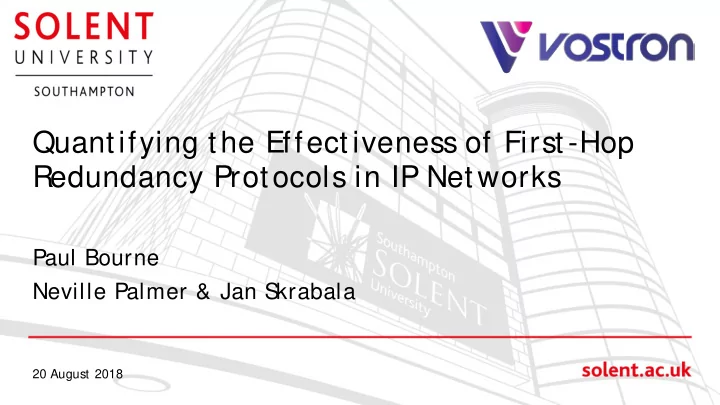

Click to edit Master title style Quantifying the Effectiveness of First-Hop Redundancy Protocols in IP Networks Paul Bourne Neville Palmer & Jan S krabala 20 August 2018
Click to edit Master title style Presentation Outline • S takeholders • Background • Investigation • method • results and discussion • recommendations and conclusions • Questions and Answers
Click to edit Master title style First Hop Redundancy Protocols Hierarchical Enterprise Campus High Availability Networks Design Architecture (Cisco, 2008) (Cisco, 2018)
Click to edit Master title style Method • Metered secondary link • without load balancing • failover based on tracking obj ect • HS RP: Hot S tandby Routing Protocol • GLBP: Gateway Load Balancing Protocol • VRRP: Virtual Router Redundancy Protocol • enable NTP and debug logging • shut primary interface G0/ 0 • monitor line protocol and FHRP • also 100 ms continuous PING
Click to edit Master title style Method • Metered secondary link • without load balancing • failover based on tracking obj ect • HS RP: Hot S tandby Routing Protocol • GLBP: Gateway Load Balancing Protocol • VRRP: Virtual Router Redundancy Protocol Hello Hold Preemption Interval Timer Delay Priority • enable NTP and debug logging 3 10 0 - HSRP D 1 3 0 - HSRP R • shut primary interface G0/ 0 3 10 30 - GLBP D • monitor line protocol and FHRP 1 3 3 - GLBP R • also 100 ms continuous PING 1 - 0 100/110 VRRP D 1 - 0 253/254 VRRP R
Click to edit Master title style Results and Discussion Mean Failover Times Mean Restoration Times Min Max Mean Dropped Min Max Mean Dropped 03.390 05.643 04.780 55 25.133 34.931 29.635 0 HSRP D HSRP D 03.818 05.561 05.067 55 HSRP R HSRP R 25.312 29.521 27.876 0 32.456 34.392 33.339 55 32.507 36.524 34.253 0 GLBP D GLBP D 03.604 04.020 03.858 55 03.284 04.295 04.040 0 GLBP R GLBP R 02.757 03.389 03.112 55 VRRP D VRRP D 02.372 03.363 02.989 0 02.316 02.969 02.665 55 02.236 02.970 02.583 0 VRRP R VRRP R • VRRP fastest in failover and restoration with both configurations • followed by HS RP and GLBP wit h default configuration • followed by GLBP and HS RP wit h rapid configurat ion • GLBP largely affect ed by 30 s default pre-empt ion delay • HS RP took longer to failover with the rapid configuration • also slow t o rest ore links • t he curious case of t he PING
Click to edit Master title style Results and Discussion Mean Failover Times Mean Restoration Times Min Max Mean Dropped Min Max Mean Dropped 03.390 05.643 04.780 55 25.133 34.931 29.635 0 HSRP D HSRP D 03.818 05.561 05.067 55 HSRP R HSRP R 25.312 29.521 27.876 0 32.456 34.392 33.339 55 32.507 36.524 34.253 0 GLBP D GLBP D 03.604 04.020 03.858 55 03.284 04.295 04.040 0 GLBP R GLBP R 02.757 03.389 03.112 55 VRRP D VRRP D 02.372 03.363 02.989 0 02.316 02.969 02.665 55 02.236 02.970 02.583 0 VRRP R VRRP R • VRRP fastest in failover and restoration with both configurations • followed by HS RP and GLBP wit h default configuration • followed by GLBP and HS RP wit h rapid configurat ion • GLBP largely affect ed by 30 s default pre-empt ion delay • HS RP took longer to failover with the rapid configuration • also slow t o rest ore links • t he curious case of t he PING
Click to edit Master title style Recommendations and Conclusions • VRRP appears to be the most responsive protocol • also has more flexibilit y • and is an open st andard • VRRP removed authentication, which may cause concern • should be implement ed wit hin a closed part of t he net work behind firewall and ACL • alt ernat ively use FHRP where load balancing is not required • or GLBP where load balancing is needed but adj ust t he t imers t o opt imise • Low hold and pre-emption delays should be set with consideration for flapping connections and boot time of devices – measure both to inform design
Click to edit Master title style Recommendations and Conclusions • Investigation raised several queries: • consider rout ing prot ocol configurat ion and it s int eract ion wit h FHRP • reduce t imers furt her t o find t he minimum failover t ime using msec • invest igat e t he logging process t o det ermine t he accuracy of t imest amps • monit or packet flows t o verify validit y of t imest amps • int roduce load balancing and mult iple st andby devices • Confident that the method produced valid relative results • not convinced by t he accuracy of t he absolut e values recorded • Compare observed behaviour with packet simulators: Packet Tracer, GNS 3 or Riverbed Modeller • simulat ors rely on an accurat e implement at ion of S W and modelling of HW • use t o predict result s and discount null hypot hesis • find opt imal configurat ions: prot ocol overhead, st abilit y and performance
Click to edit Master title style Questions and Discussion Paul Bourne paul.bourne@ solent .ac.uk Neville Palmer neville.palmer@ solent .ac.uk Jan S krabala j an@ vost ron.com References: Cisco 2008. Campus Network for High Availability Design Guide [accessed 15/05/18]. Available: https://www.cisco.com/c/en/us/td/docs/solutions/Enterprise/Campus/HA_campus_DG/hacampusdg.html Cisco, 2018. First Hop Redundancy Protocols Configuration Guide [accessed 15/05/18]. Available: https://www.cisco.com/c/en/us/td/docs/ios-xml/ios/ipapp_fhrp/configuration/xe-16/fhp-xe-16-book/fhp- hsrp-mgo.html
Recommend
More recommend